Dear friends, colleagues!
Welcome to the website of the National Atherothrombosis Society (NOAT). The National Society for Atherothrombosis was organized in 2004 on the initiative of the All-Russian Scientific Society of Cardiologists (VNOK), the Russian Society of Angiologists and Vascular Surgeons and the National Association against Stroke (NABI). The NOAT team included renowned cardiologists and neurologists, vascular surgeons, lipidologists and specialists in the field of coagulology, clinical pharmacologists and pathophysiologists. NOAT is an associated member of the Russian Society of Cardiology
The main objective of the Society is to promote the development of scientific research and unite the efforts of doctors in the prevention and treatment of cardiovascular diseases, which are based on atherothrombosis. To this end, NOAT specialists annually conduct more than 20 schools and seminars in various regions of the country. Thousands of cardiologists, internists, neurologists and general practitioners improve their qualifications there. NOAT specialists take part in the largest Russian and international medical congresses.
Since 2008, the journal “Atherothrombosis” has been published in Russia, which is included in the list. publications recommended by the Higher Attestation Commission. Experts from NOAT and VNOK (now RKO) have created recommendations for practitioners on the diagnosis and treatment of stable manifestations of atherothrombosis, approved by the Congress of Cardiologists of the Russian Federation. NOAT experts took an active part in the creation of national recommendations devoted to the problem of atrial fibrillation, acute coronary syndromes, and venous thromboembolic complications.
With the creation of the NOAT website, a new source of information has appeared about the problem of thrombosis, diseases of the circulatory system, complications, and antithrombotic therapy. We hope that the information presented on the site will help not only practitioners, but also patients who will be able to become familiar with new therapeutic (medicinal and non-medicinal) options for reducing the risk of atherothrombosis, including myocardial infarction and stroke.
With the help of the site, it became possible to receive the most complete information about the work of Ateroschools and other scientific events organized under the auspices of NOAT. The website publishes the main materials presented in schools for practicing doctors, all issues of the journal “Atherothrombosis” are presented. The scientific direction of NOAT and the main research results were approved by the Bureau of Clinical Medicine of the Russian Academy of Sciences.
We hope that the website of the National Society for Atherothrombosis, being a combination of science and practice, will help us actively and productively fight this dangerous disease.
Chairman of the Supervisory Board of NOAT Doctor of Medical Sciences, Professor E.P. Panchenko
Helpful information
The heart is a muscular organ that pumps blood throughout the body. To function well, the heart requires oxygen, which is supplied by the bloodstream.
What is ischemic, or coronary, heart disease?
The basis of coronary heart disease is the gradual narrowing and blockage of the coronary arteries due to the deposition of fatty deposits called plaques on their walls. Plaques reduce the lumen of the artery, which leads to slow blood flow and insufficient nutrition of the heart muscle.
What is angina?
Angina pectoris is a signal that the heart muscle is receiving little oxygen and nutrients, which is expressed by the appearance of chest pain. Most often, angina develops during physical or emotional stress, which forces the heart to work more intensely. The pain may be accompanied by a feeling of tightness in the chest, heaviness, burning or squeezing behind the sternum. Typically, angina pectoris during exercise develops when the lumen of a large artery decreases by more than 50%. If the lumen is reduced by 90%, angina attacks can develop at rest. When less oxygen and nutrients enter the myocardial cell, metabolic disorders develop. This entire process of development of ischemia can be represented as an iceberg, the tip of which is the pain felt by a patient with angina pectoris, and the basis is metabolic disorders in the myocardial cell.
How long does angina pain last?
In most cases, the attack lasts no more than 5 minutes, but the duration can vary. Pain is usually relieved by taking nitroglycerin.
How is angina different from myocardial infarction?
In angina, blood flow to the heart muscle is partially reduced due to a temporary narrowing of the coronary artery. In a myocardial infarction, the blood supply to the heart muscle stops suddenly and completely due to a blockage in the coronary artery. As a result, the heart muscle dies. The presence of angina attacks significantly increases the risk of developing myocardial infarction.
In what cases should myocardial infarction be suspected?
Angina attacks become longer and more intense. Painful sensations persist regardless of movement and breathing. A feeling of fear, nausea, vomiting, sweating, a feeling of lack of air, and shortness of breath appear. No effect from taking nitroglycerin for 10 minutes.
Is angina treatable?
Yes. Your doctor will prescribe the drug that is most suitable for you, which will reduce the frequency of attacks and the intensity of pain. There are drugs that reduce or prevent the number of angina attacks by reducing myocardial oxygen demand or increasing its supply. These are beta blockers, nitrates, calcium antagonists. Currently, another group of drugs has appeared - myocardial cytoprotectors, which prevent ischemic cell damage and reduce the number of angina attacks, but through a different mechanism: influencing the “base of the iceberg” - metabolic processes directly in the myocardial cell. Remember that only a doctor will select the treatment you need in the required dose!
How should I change my lifestyle?
Follow a diet limiting the amount of salt consumed to 3g/s and fatty foods. Increased blood levels of cholesterol (C), triglycerides (TG), LDL cholesterol, this is the so-called “bad” cholesterol, contributes to the formation of atherosclerotic plaques in the coronary, cerebral, mesenteric arteries, as well as in tissues and internal organs (liver, pancreas) .
Cholesterol content in food (mg)
| Finished Products | Cholesterol in mg |
| Canned cod liver (100g) | 476 |
| Beef liver (100g) | 438 |
| Egg (yolk) | 202 |
| Chicken stomach (100g) | 212 |
| Shrimp (100g) | 150 |
| Fish caviar - pollock, red, black (100g) | 300 |
| Kidneys (100g) | 112 |
| Butter (50g) | 121 |
| Condensed milk (1 cup) | 2 |
| Sour cream 30% (1 teaspoon) | 5 |
| Fat cheese (25g) | 23 |
| Mayonnaise (1 teaspoon) | 5 |
| Chickens, white meat, wings, breast with skin (100g) | 80 |
| Boiled sausage (100g) | 60 |
| Milk 6%, fermented baked milk (1 glass) | 47 |
| Pork without fat (100g) | 88 |
Following the diet can lower blood pressure and cholesterol levels and promote weight loss. It is very important to quit smoking. Moderate exercise under the supervision of a doctor can strengthen the heart muscle and help the heart use oxygen more efficiently.
What can I expect in the future?
A healthy lifestyle and regularly taking medications prescribed by your doctor will help you live a longer, more active and fulfilling life.
The following tips will help you live a fulfilling life.
Follow all recommendations of your doctor;
Follow step by step to a healthy lifestyle;
Control your weight;
Have a clear understanding of the situations that cause angina attacks;
Keep a diary of self-monitoring of blood pressure, heart rate, and angina attacks.
Cardiologist Lador T.V.
Print Email
What should physical therapy be like?
To achieve good results, when prescribing exercise therapy for angina pectoris, a set of exercises is selected taking into account the patient’s condition. Gymnastics is allowed only in the first two stages of the disease. If the course of angina is severe, leisurely walks are needed, preferably in green areas.
Therapeutic physical training is one of the most effective means in the fight against angina pectoris
Physical therapy is prescribed in this way, for example:
- It takes into account what stage of development the disease is at, how long painful attacks last and how often they occur. With a mild form, the load may be more intense. In case of severe angina - minimal;
- the entire therapeutic complex of gymnastics consists of three components - warm-up, main part, cool-down. During the warm-up, the body is adjusted to accept the load. The main part of the exercises for angina pectoris is aimed at obtaining a reasonable load on all organs and systems of the patient’s body. During the cool-down, make a smooth exit from the set of exercises without jumps in blood pressure;
- the set of tasks should not contain exercises with sudden movements.
Are there any restrictions for physical education?
An important task during angina attacks is to control the pressure from its sudden changes, as well as to prevent the development of hypertension. That is why you need to make sure that there is no overload, both physically and emotionally. In addition, you should not drink a lot of coffee or eat spicy and salty foods, as this can overstimulate the body and increase blood pressure. It is harmful to make sudden movements during angina, as the vessels are depleted. In almost all cases of this disease, sanatorium treatment is not prescribed.
Breathing according to Strelnikova
There is a wide variety of breathing exercises in this system. There are also exercises that allow you to get rid of them in emergency situations during severe angina attacks.
An equally effective type of therapy is breathing exercises for angina pectoris.
Here are some of them:
- Sit on a chair or kneel on the floor, eyes closed.
- Inhale sharply to compress the chest muscles.
- Do not hold your breath, but immediately exhale slowly.
- Continue inhaling and exhaling until the pain stops.
After the attack ends, the patient needs rest. If the pain does not subside, you need to call an ambulance.
What does the main complex consist of?
The entire basic complex of physical therapy for angina pectoris is performed from a standing position.
The following exercises are done with a minute pause for rest:
- Sit down, stretching your arms in front of you (start with 10 squats, later increase the number to 30).
- I. p. – legs slightly apart. The body is parallel to the floor. Hands are spread to the sides. Perform turns left and right, stretching as far as possible. Initial quantity 10 times, increase to 50.
- I. p. – legs are shoulder-width apart. Raise one arm, bend in the opposite direction, do the same for the other arm. In each direction from 10 to 30 times.
- Slow running in place, gradually accelerating, 10 minutes. If you have a treadmill, you can do it on it.
Breathing according to Buteyko
The main principle of the Buteyko breathing technique is to reduce the frequency of respiratory movements while increasing the quality of the respiratory process.
The main positions when performing breathing are the following:
- the number of inhalations and exhalations cannot be more than 16;
- You need to breathe strictly through your nose. Breathing through the mouth is not only harmful, but also poses a danger to humans;
- you need to breathe slowly and naturally;
- you need to inhale twice as long as you exhale;
- After inhalation, a delay should be performed.
An approximate set of Buteyko exercises:
- Sit on a chair with your eyes closed, keep your back straight, and place your hands on your knees.
- Inhale for 10 seconds, hold your breath for 20 seconds, then exhale for 20 seconds. It will not be possible to complete such a period of time from the first lessons. The main thing is to maintain the 1x2x2 proportions and feel comfortable.
The Buteyko breathing technique is a step-by-step transition to light breathing according to the following scheme: inhale – pause – deep exhale. There should be no tension felt.
Breathing according to Bubnovsky
This technique involves breathing in which the diaphragm is involved, and chest breathing is reduced to a minimum. You need to know that many medical specialists point out the dangers of chest breathing.
An approximate set of breathing exercises:
- Sit on your knees, close your eyes, feel the diaphragm - the area in the middle of the peritoneum and chest.
- Inhale slowly for a count of five, gradually increasing your diaphragm and tensing your muscles. Freeze, count to three, fixing this state of the diaphragm. Exhale gradually, counting to 5. Retract the diaphragm using muscle force. Perform – starting with 20 breaths and working up to 50.
- Get on all fours, relax your abdominal muscles. Make breathing movements with effort and quickly for one minute. In the future, increase the duration to 10 minutes.
If severe dizziness is observed, breathing exercises should be interrupted. Next time start with small doses.
There are several types of breathing exercises
How to warm up
First of all, physical exercises for angina pectoris begin with a warm-up. To ensure that the load is not excessive, it is carried out lying on the floor (a gymnastic mat is laid out):
- Inhale and exhale deeply 3 times. This will give the mood for the whole complex.
- Sit on the carpet. Raise your left hand - lean to the right, do the same in the other direction. Repeat 10 bends in each direction. Rest for 1 minute, then do two more approaches.
- Lie down. Bend and straighten your knees 10 times. Rest 1 minute, then two sets.
It is important to choose the right set of exercises
How to finish gymnastics with angina pectoris
The cool-down is done while sitting on the floor. Keep your legs straight, do not bend your knees. Hands reach to the tips of the toes. Try to reach your knee with your head. Don't rush, do it slowly. Lie down, rest, and restore your breathing.
When performing physical exercises with angina, it is important not to overdo it. At the slightest discomfort in the heart area, you need to stop. Also lie down and try to take deep breaths in and out to normalize your breathing.
If this method does not help, you should take drugs from the nitrate group “Nitroglycerin” or “Sidnopharm”.
The duration of the workout should not be more than 10-15 minutes







